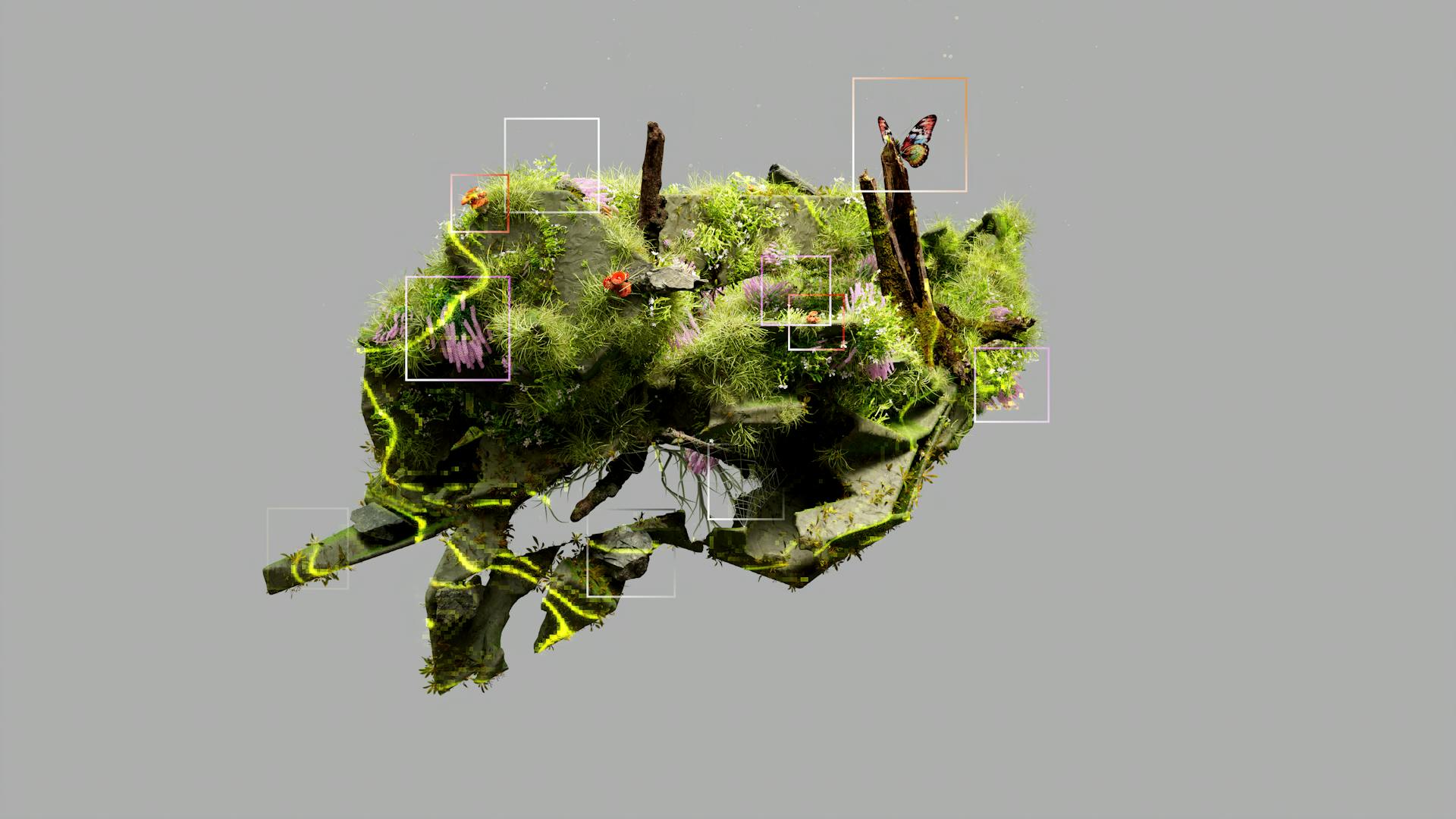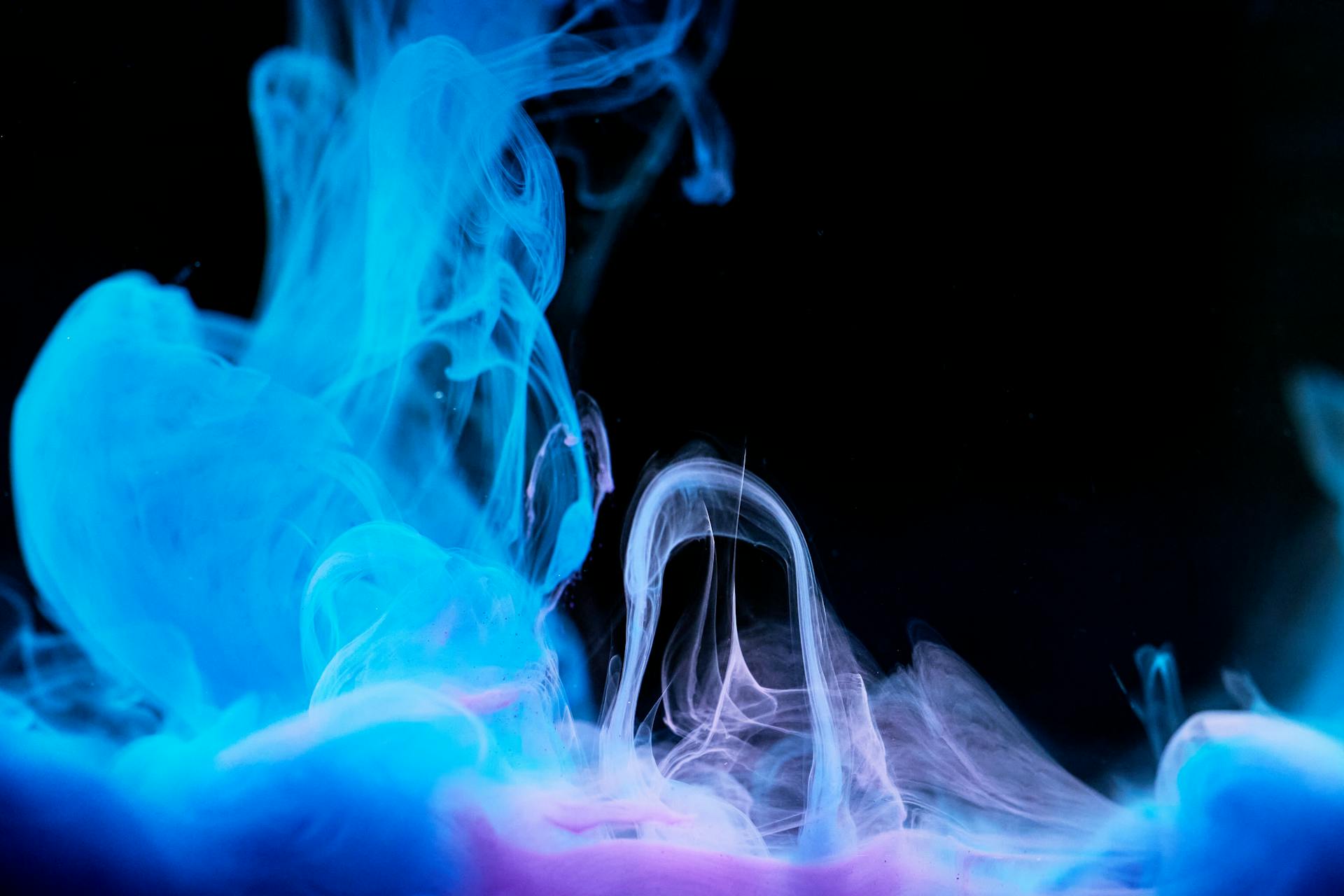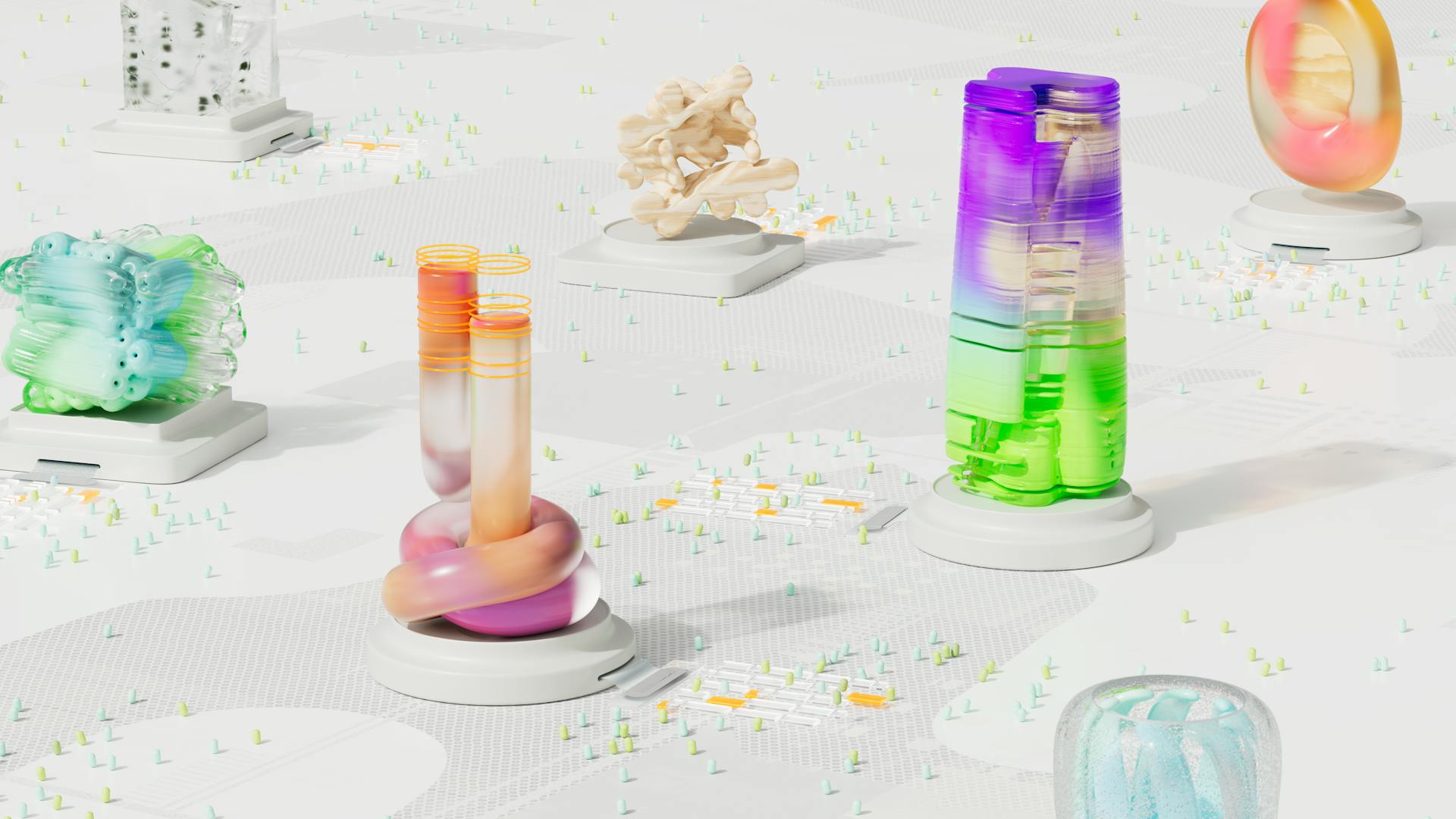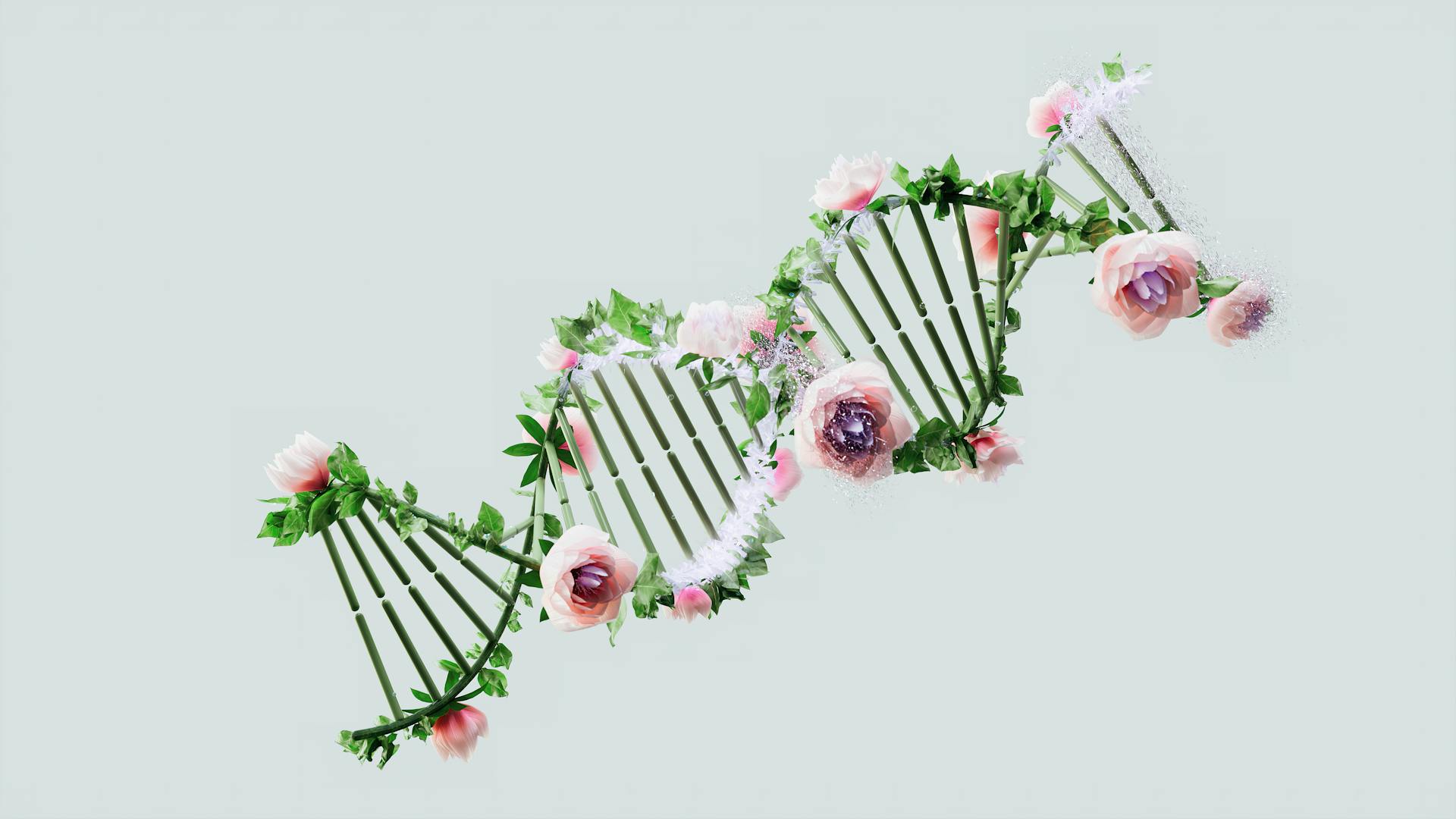
Artificially intelligent art is no longer just a concept, it's a reality that's transforming the way we create and interact with art. AI algorithms can now generate stunning images, music, and even entire films on their own.
In 2018, the AI-generated portrait "Edmond de Belamy" sold for $432,500 at Christie's auction house, marking a significant milestone in the acceptance of AI art. This portrait was created by the French art collective Obvious using a generative adversarial network (GAN) algorithm.
AI art is not just limited to visual arts; it's also being used to create music. A 2019 study found that AI-generated music can be indistinguishable from human-created music, raising questions about authorship and creativity.
For your interest: Generative Ai Human Creativity and Art
History and Evolution
AI-generated art has a rich history that spans over five decades. The first significant AI art system, AARON, was developed by Harold Cohen in the late 1960s.
AARON used a symbolic rule-based approach to generate technical images. It was initially exhibited in 1972 at the Los Angeles County Museum of Art.
Discover more: Ai Art Data Poisoning
Artificial life was also explored in the 1980s by Karl Sims, who received an M.S. in computer graphics from the MIT Media Lab in 1987. He won the Golden Nica award at Prix Ars Electronica for his 3D AI animated videos in 1991 and 1992.
In the 2010s, deep learning caused a significant shift in the world of AI art. The generative adversarial network (GAN) was developed in 2014 by Ian Goodfellow and colleagues at Université de Montréal.
Early History
The concept of automated art dates back to ancient Greek civilization, where inventors like Daedalus and Hero of Alexandria designed machines capable of writing text, generating sounds, and playing music.
Maillardet's automaton, created around 1800, was a notable example of a creative automaton, capable of creating multiple drawings and poems stored in its "cams", the brass disks that hold memory.
Ada Lovelace, known for her work on the analytical engine, conceptualized the idea of using computing operations to generate music and poems, leading to what is now referred to as "The Lovelace Effect."
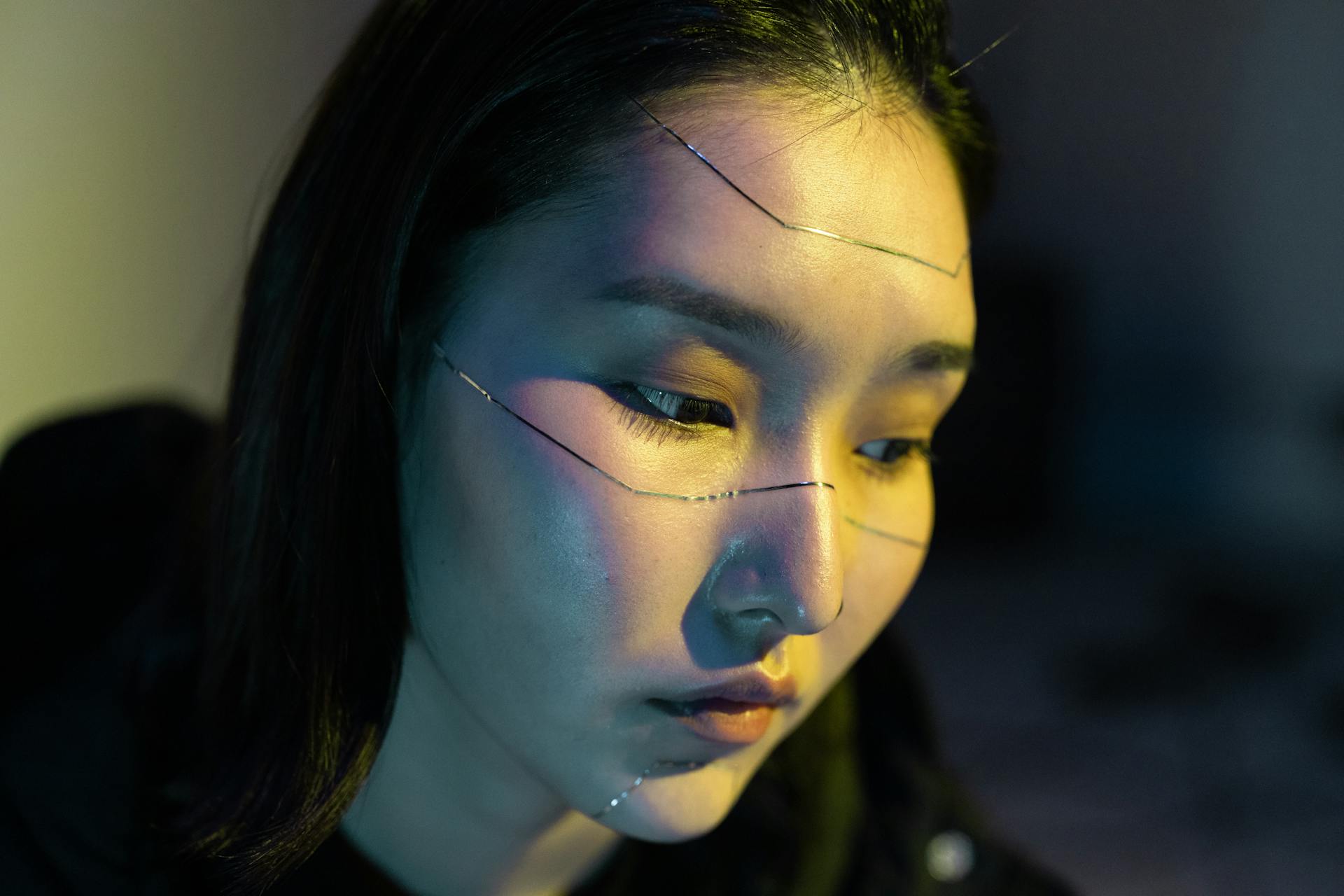
However, Lovelace also discussed the idea of "The Lovelace Objection", arguing that machines have "no pretensions whatever to originate anything", which is a direct contradiction to the idea of artificial intelligence and creative machines.
In 1950, Alan Turing's paper Computing Machinery and Intelligence shifted the focus from defining intelligence in abstract terms to evaluating whether a machine can mimic human behavior and responses convincingly.
The academic discipline of artificial intelligence was founded at a research workshop at Dartmouth College in 1956, marking a significant milestone in the field's development.
Early Implementations (1950s-2000s)
The early days of AI art were marked by pioneers like Harold Cohen, who developed AARON, a significant AI art system, starting in the late 1960s at the University of California at San Diego.
AARON used a symbolic rule-based approach to generate technical images, and Cohen's goal was to code the act of drawing. Throughout the years, Cohen refined AARON, and it was exhibited in 1972 at the Los Angeles County Museum of Art.
For your interest: Generative Ai Human Creativity and Art Google Scholar
In the 1980s, Karl Sims began exhibiting art created with artificial life, and he received an M.S. in computer graphics from the MIT Media Lab in 1987.
Sims was artist-in-residence from 1990 to 1996 at Thinking Machines, a supercomputer manufacturer and artificial intelligence company, and he won the Golden Nica award at Prix Ars Electronica in both 1991 and 1992.
Eric Millikin has been creating animated films using artificial intelligence since the 1980s, and he started posting art on the internet using CompuServe in the early 1980s.
Scott Draves and a team of engineers created Electric Sheep in 1999, a free software screensaver that used AI to create an infinite animation by learning from its audience.
Draves won the Fundacion Telefonica Life 4.0 prize for Electric Sheep in 2001, and the screensaver was a volunteer computing project for animating and evolving fractal flames.
Evolution of
The evolution of AI in art has been a remarkable journey. From being primarily a tool for artists to aid in their creative process, AI has now taken on a more autonomous role in the creation of artworks.
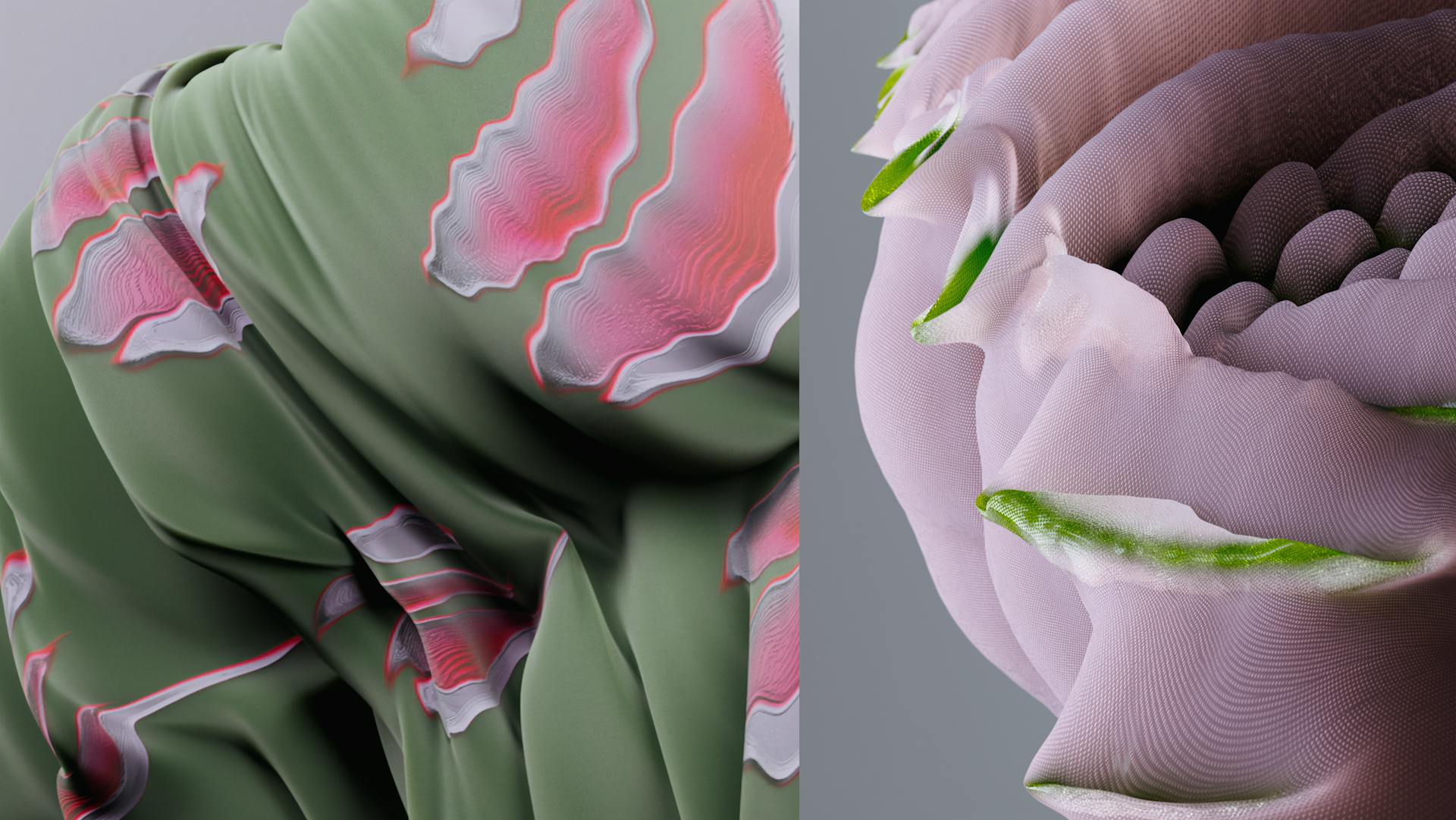
AI's multi-layer structure, mimicking the human brain, first emerged in the 2010s and caused a significant shift in the world of AI art. This era saw the development of various generative art models, including autoregressive models, diffusion models, GANs, and normalizing flows.
In 2014, Ian Goodfellow and colleagues developed the generative adversarial network (GAN), a type of deep neural network capable of learning to mimic the statistical distribution of input data such as images.
The GAN uses a "generator" to create new images and a "discriminator" to decide which created images are considered successful.
The first auction sale of AI art was held at Christie's in New York in 2018, where the AI artwork Edmond de Belamy sold for US$432,500.
This marked a significant milestone in the recognition of AI-generated art as a legitimate form of creative expression.
A unique perspective: New Artificial Intelligence Program
Artificial Intelligence in Art
Artificial intelligence (AI) is being used to create stunning works of art, from portraits to surrealist landscapes. This is made possible by tools like generative adversarial networks (GANs) and deep learning algorithms.
The possibilities for AI art are endless, with artists able to define positive and negative prompts, use various techniques like VAEs and LorAs, and even train their own models. This means that the art world is being opened up to new forms of creative expression.
AI art can be used to assist the creative process, helping artists to speed up their workflows and generate new ideas. Concept artist Brandon Reimchen uses AI art to produce base concepts for clients, or to provide multiple options when a brief is still undefined. He believes that AI art should be seen as a tool, not a hindrance to artists.
However, understanding the fundamentals of art and learning essential technical and creative skills is still a prerequisite to becoming a successful digital painter. Brandon advises his students not to rely on AI art if they want to improve as artists, and instead to practice and learn from their mistakes.
AI-generated art is already being recognized as a legitimate form of art, with works like "Edmond de Belamy" being displayed in museums and auctioned off for thousands of dollars. This raises questions about the role of AI in the art world and the nature of artistic expression.
Generative Models
Generative models have revolutionized the world of artificially intelligent art. These models can generate new and original art pieces by learning from data inputs and applying algorithms.
The 2020s saw a significant shift in the creation of AI-generated artworks with the rise of text-to-image models, which generate images based on prompts. One such model is DALL-E, released by OpenAI in 2021, which uses large language generative pre-trained transformer models to create vivid visual creations.
In 2022, diffusion models became better than GANs, with latent diffusion model being published in December 2021 and becoming the basis for the later Stable Diffusion. Stable Diffusion was released in August 2022 and has a main pre-trained model shared on the Hugging Face Hub.
Artbreeder's platform allows users to blend and morph images to create new and enchanting artworks, showcasing the potential of GAN to generate diverse and appealing visual content. RunwayML's utilization of VAEs results in a variety of visually striking outputs, demonstrating the artistic possibilities introduced by VAEs in the generative art landscape.
For your interest: Transformers the Movie Artworks
The collaboration between AI and human artists introduces a dynamic interplay between predetermined algorithms and spontaneous human creativity. This collaborative approach yields visually striking artworks and emphasizes AI's potential to augment and complement human artistic endeavors.
Here are some key generative models mentioned in the article:
- DALL-E: a text-to-image model that generates vivid visual creations
- Stable Diffusion: a diffusion model that generates synthetic data based on existing data
- Artbreeder: a platform that allows users to blend and morph images to create new and enchanting artworks
- RunwayML: a tool that utilizes VAEs to generate a variety of visually striking outputs
- Midjourney: an AI Digital Art System that produces content based on user input, including an initial uploaded image as their starting point.
Copyright and Ethics
AI art cannot be fully copyrighted in the United States, as the U.S. Copyright Office does not consider works created by non-humans eligible for copyright.
Creators may lose control over how their work gets distributed and used, and they may miss out on potential income if their art is copied, modified, and sold without permission or compensation.
The root of this issue lies in the way AI art generators work, which involves recognizing patterns in existing data and replicating those patterns in new ways to form original works of art.
In essence, AI-generated art is a culmination of other people's work, much of which is copyright protected in its own right.
Curious to learn more? Check out: Artificial Intelligence and Future of Work
If a human collaborates with a machine to create art, only the human's contributions to the piece are eligible for copyright, not the prompts used to instruct the generator.
The guidelines essentially say that you need to have created the work, and since the AI is making the choices, the human hasn't done the work necessary to create art.
The legality of AI art exists in a gray area, with primary issues involving fair use and intellectual property, and the question of authorship and ownership remains unanswered.
AI art isn't protected by U.S. copyright laws, so creators may face challenges in asserting their rights over their work.
Examples and Applications
Artificially intelligent art has the potential to transform the way we create and interact with art. AI can enable the expansion of noncommercial niche genres, such as cyberpunk derivatives like solarpunk, by amateurs.
Novel forms of entertainment are emerging, thanks to AI's ability to generate drafts, draft-refinements, and image components. This can save time and effort, allowing artists to focus on more complex tasks.
Generated images can be used as sketches, low-cost experiments, inspiration, or illustrations of proof-of-concept-stage ideas. AI art has captured global attention, sparking both fascination and frustration.
Some notable examples of AI-generated art have gained international recognition. These works demonstrate the potential of AI to create innovative and thought-provoking art.
By mastering the art of creating effective text prompts, designers can unlock the full potential of AI-generated art. This can lead to new and exciting forms of artistic expression.
Software and Tools
Artificially intelligent art is created using a variety of software and tools. Artbreeder's platform allows users to blend and morph images to create new and enchanting artworks.
Some popular tools used to create AI art include Artbreeder, RunwayML, DALL-E by OpenAI, NVIDIA GauGAN, and Midjourney. These tools utilize different AI technologies such as Generative Adversarial Networks (GANs) and Variational Autoencoders (VAEs) to generate unique and captivating artworks.
Here are some key features of these tools:
- Artbreeder: allows users to experiment with various parameters to create visually stunning compositions
- DALL-E by OpenAI: can transform text prompts into vivid visual creations
- NVIDIA GauGAN: turns rough sketches into stunningly realistic landscapes
- Midjourney: offers artists a platform to create unique and personalized artworks
DeepArt.io is another AI technology that can take a user-uploaded image and transform it into a stylized version of the original. It offers a variety of styles and customization options for users to experiment with.
Software and Tools
Artbreeder is a platform that allows users to blend and morph images to create new and enchanting artworks. This tool is a great example of how AI can be used to generate diverse and appealing visual content.
Artbreeder's interface is user-friendly, making it accessible to artists of all levels. RunwayML's utilization of VAEs results in a variety of visually striking outputs, allowing artists to produce artwork with unpredictable and dynamic elements.
Artbreeder and RunwayML are just two examples of the many tools available for creating AI-generated art. Another tool worth mentioning is DALL-E by OpenAI, which shows how text prompts can be transformed into vivid visual creations.
DALL-E's capabilities are impressive, and it's easy to see why it's a popular choice among artists. NVIDIA GauGAN, on the other hand, turns rough sketches into stunningly realistic landscapes.
Here are some popular AI art-generating tools:
- Artbreeder
- RunwayML
- DALL-E by OpenAI
- NVIDIA GauGAN
- Midjourney
- DeepArt.io
These tools offer a range of capabilities, from blending and morphing images to generating realistic landscapes. They're a great starting point for anyone interested in exploring the world of AI-generated art.
Power Usage
Generating images using AI models like Stable Diffusion can be quite power-hungry. According to researchers, generating 1,000 1024×1024 images using Stable Diffusion's XL 1.0 base model requires 11.49 kWh of energy.
This is a significant amount of energy, equivalent to driving an average gas-powered car a distance of 4.1 miles (6.6 km). In fact, researchers found that image-generation models used on average around 2.9 kWh of energy per 1,000 inferences.
Should Use?
Should you use AI in your creative process? Artists shouldn't shun new technology, like AI art, because it may result in getting left behind.
Getting good at being technically sound as an artist is crucial, so you can use AI art if you need to. This means having a solid foundation in art fundamentals.
If art becomes about simply pressing buttons, you'll be the better "button presser" than someone who has no art fundamentals.
Take a look at this: Safe Secure and Trustworthy Development and Use of Artificial Intelligence
Impact and Controversies
The emergence of artificially intelligent art has sparked heated debates in the art world. AI-generated art is at the center of several heated legal and ethical debates due to copyright concerns and fears of human artists being replaced.
The use of AI art raises complex issues around copyright, particularly around ownership and originality. This is because AI art is created using existing artworks as training data, which can lead to disputes over who owns the rights to the final product.
The technology behind AI art has also been misused in malicious ways, including phishing attacks, phone scams, and the nonconsensual creation of pornographic images using deepfakes.
What Is & How Will It Impact?
Understanding AI art and its potential impact on artists is crucial for making it work for you rather than against you. AI art is a rapidly evolving field that's already changing the creative landscape.
AI art is created using algorithms and neural networks that can generate unique images, often indistinguishable from those created by humans. Understanding its strengths and limitations is key to harnessing its potential.
The key to making AI art work for you is to know its limitations, as mentioned in the article. AI art excels in tasks that require repetition and pattern recognition, but may struggle with originality and creativity.
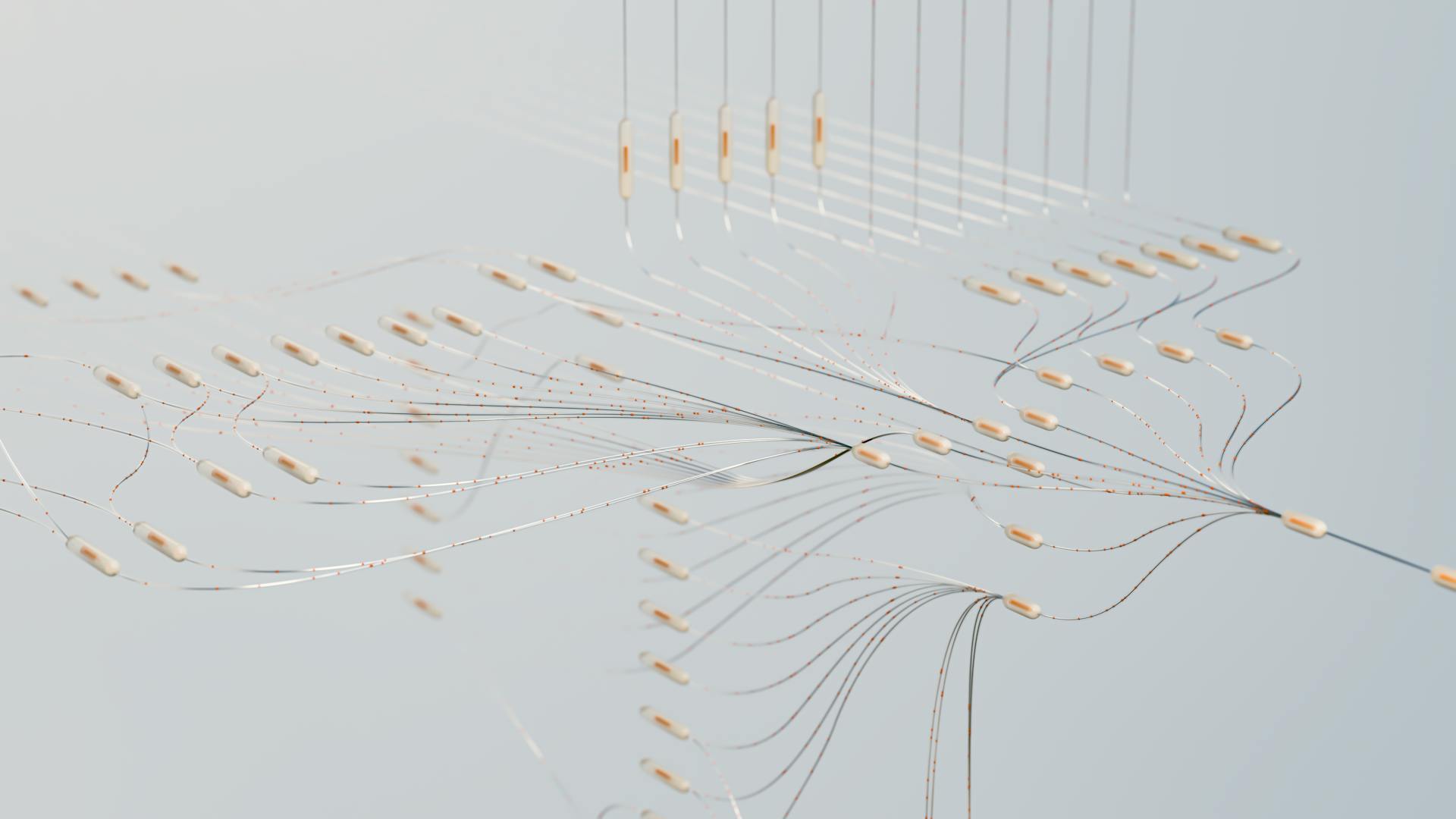
AI art can be used as a tool to enhance human creativity, rather than replace it. By understanding how AI art works and its potential applications, artists can use it to streamline their workflow and focus on high-level creative decisions.
AI art's potential impact on the art world is still being explored, but it's clear that it will change the way we create and consume art.
Why Is Controversial?
AI art is a double-edged sword, and its controversies are multifaceted.
Some people worry that AI art devalues traditional artistic skills, as it can generate high-quality images with ease, making it seem like anyone can create art without putting in the effort.
Artists are concerned about authenticity and creativity, as AI art lacks the ability to capture human expression in the same way.
AI art raises complex issues around copyright, particularly around ownership and originality, as it often utilizes existing artworks as training data.
The technology used to make AI art is increasingly being used in malicious ways, including phishing attacks, phone scams, and the nonconsensual creation of pornographic images using deepfakes.
AI-generated images and art can perpetuate biases present in training data, as seen in the Stable Diffusion model, which showed racial bias in its output.
Generative AI models can also perpetuate harmful stereotypes regarding women, such as Lensa's AI app, which trended on TikTok in 2023, was known to lighten black skin, make users thinner, and generate hyper-sexualized images of women.
Google's chatbot Gemini was criticized for perceived racial bias, with claims that it deliberately underrepresented white people in its results.
Artificial intelligence has shaken up the art world, creating significant controversy along the way, and it's essential to acknowledge these concerns to navigate the delicate balance between leveraging AI's capabilities and preserving the irreplaceable aspects of human creativity in art.
The sampling bias found within AI training data can lead to discriminatory output from AI art models, as researchers at Princeton University found in 2017.
AI art can perpetuate stereotypes and biases, and it's crucial for both artists and AI developers to understand these limitations and work together to create inclusive and respectful art.
AI-generated art can lack the depth, symbolism, or personal narratives that often characterize human-created artworks, as AI lacks a true understanding of the meaning behind the art it generates.
Related Topics
Synthetic media, which includes AI art, is a major technology-driven trend that will affect business in the coming years.
Synthography is a proposed term for the practice of generating images that are similar to photographs using AI. This field is rapidly evolving and has the potential to revolutionize the way we create and interact with visual content.
Frequently Asked Questions
What is the most powerful AI art?
Jasper Art is considered a powerful AI art generator, offering high-quality results, but it comes at a higher cost. If you're already invested in the Jasper ecosystem, it's worth exploring for its art capabilities.
Sources
- https://en.wikipedia.org/wiki/Artificial_intelligence_art
- https://builtin.com/articles/what-is-ai-art
- https://www.interaction-design.org/literature/topics/ai-generated-art
- https://medium.com/higher-neurons/the-ten-most-influential-works-of-ai-art-820c596b8840
- https://www.cgspectrum.com/blog/what-is-ai-art-how-will-it-impact-artists
Featured Images: pexels.com
